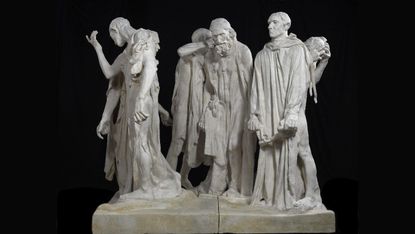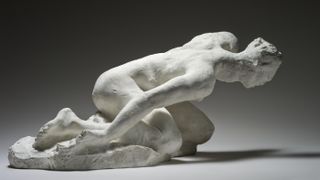Exhibition of the week: The Making of Rodin
For all its strengths, the show is let down by a needlessly ‘censorious’ attitude towards its subject

In 1899, Auguste Rodin mounted a “decidedly unconventional” exhibition in Paris, said Rachel Campbell-Johnston in The Times. Rodin (1840-1917) took the decision to show his works in plaster, a material hitherto considered only as a “transitional” part of the process by which a sculpture progressed from the drawing board to its finished state in bronze or marble. The artist aimed both to “emphasise the fundamental role” that plaster played in the development of his “audacious modern vision”, and to “mythologise himself as a solitary genius”; because unlike bronze cast, a work in plaster would bear the imprint of his hand. The resulting show was “a muddle of figures and fragments and maquettes”, evoking the atmosphere of the artist’s studio. It would, the curators of a new exhibition at Tate Modern argue, set the pace for sculpture in the 20th century.
In its first exhibition to open since lockdown restrictions were relaxed, the museum sets out to replicate the thrill of Rodin’s groundbreaking display, bringing together more than 200 works, mostly in plaster. The Making of Rodin includes many of his most famous sculptures and reminds us that he was unquestionably “the most innovative sculptor” of his time.
In many ways, this is a “serious and accomplished” exhibition, said Alastair Sooke in The Daily Telegraph. It features a roll-call of Rodin’s “greatest hits”: several plaster versions of The Thinker (1881) and a marble of his immortal The Kiss (1901-04) are present and correct, as are less-celebrated gems such as The Age of Bronze (1876-77), an “astonishingly supple likeness of a young Belgian soldier”. Yet for all its strengths, the show is let down by a needlessly “censorious” attitude towards its subject. The curators make the mistake of judging the artist by our contemporary mores. It tells Rodin off for “appropriating” classical sculpture, which he collected. A series of “frankly erotic” studies of naked women is accompanied by a caption informing us that the relationship between artist and model was “starkly unequal”. Such “finger-wagging” is pointless and irritating: “if you don’t like the work, don’t show it”.
Subscribe to The Week
Escape your echo chamber. Get the facts behind the news, plus analysis from multiple perspectives.

Sign up for The Week's Free Newsletters
From our morning news briefing to a weekly Good News Newsletter, get the best of The Week delivered directly to your inbox.
From our morning news briefing to a weekly Good News Newsletter, get the best of The Week delivered directly to your inbox.

Any attempt to engage with the exhibition’s arguments is “futile”, said Jonathan Jones in The Guardian. The curators make a series of pretentious and historically illiterate claims about Rodin’s supposed “modernity”, repeatedly insisting that “the factory-like system he employed of churning out plaster models and bronze casts” made him a direct precursor to 20th century artists like Andy Warhol or Jeff Koons. In fact, this was common practice for many 19th century sculptors. The show offers precious little in the way of “biographical context” or iconographic analysis, and consequently risks misrepresenting Rodin’s art.
Yet enjoyed as a “purely aesthetic” experience, it is a pleasure from start to finish. Among the highlights are a full-scale plaster cast of The Burghers of Calais (1889), Rodin’s unforgettable monument to a group of 14th century volunteers who sacrificed themselves to the English to save their city. Better still is a “full-sized plaster model” for his extraordinary monument to Balzac, capturing the rotund novelist swathed in a vast dressing gown. “Intellectually confused” as it is, this show is undeniably “beautiful”.
Tate Modern, London SE1 (www.tate.org). Until 21 November
Create an account with the same email registered to your subscription to unlock access.
Sign up for Today's Best Articles in your inbox
A free daily email with the biggest news stories of the day – and the best features from TheWeek.com
-
 'Good riddance to the televised presidential debate'
'Good riddance to the televised presidential debate'Instant Opinion Opinion, comment and editorials of the day
By Harold Maass, The Week US Published
-
 Caitlin Clark the No. 1 pick in bullish WNBA Draft
Caitlin Clark the No. 1 pick in bullish WNBA DraftSpeed Read As expected, she went to the Indiana Fever
By Peter Weber, The Week US Published
-
 Today's political cartoons - April 16, 2024
Today's political cartoons - April 16, 2024Cartoons Tuesday's cartoons - sleepyhead, little people, and more
By The Week US Published
-
 Rome's Colossus of Constantine
Rome's Colossus of ConstantineWhy everyone's talking about British artist digitally reconstructs original from remaining fragments to create new statue of Roman emperor
By Harriet Marsden, The Week UK Published
-
 The Westbury Hotel review: stunning suites in charming Dublin
The Westbury Hotel review: stunning suites in charming DublinThe Week Recommends This hotel is the perfect spot to while away a weekend in Ireland's capital
By Kaye O'Doherty Published
-
 Drama movies 2024: new films out this year
Drama movies 2024: new films out this yearIn Depth Latest reviews include The Boys in the Boat, One Life and Tchaikovsky's Wife
By The Week UK Last updated
-
 Best new hotels and places to stay in 2024
Best new hotels and places to stay in 2024The Week Recommends Featuring stylish island resorts, historical properties and wilderness retreats
By The Week UK Last updated
-
 Albums of the year: best music of 2023
Albums of the year: best music of 2023The Week Recommends A look back at the best pop, rap, jazz, dance, classical and rock releases
By The Week UK Published
-
 Savoy Grill by Gordon Ramsay review: an institution reinvented
Savoy Grill by Gordon Ramsay review: an institution reinventedThe Week Recommends Traditions are maintained and the tweaks are clever and modern
By Neil Davey Published
-
 Tulum: a Mexican beach town of 'two halves'
Tulum: a Mexican beach town of 'two halves'The Week Recommends With the 'pueblo' and 'Zona Hotelera', Tulum is home to great hotels, restaurants and beach clubs
By William Leigh Published
-
 La Zebra review: beach chic, perfect tacos and secret cenotes
La Zebra review: beach chic, perfect tacos and secret cenotesThe Week Recommends Enjoy a stylish stay in Mexico at this family-friendly beach hotel and restaurant
By William Leigh Published